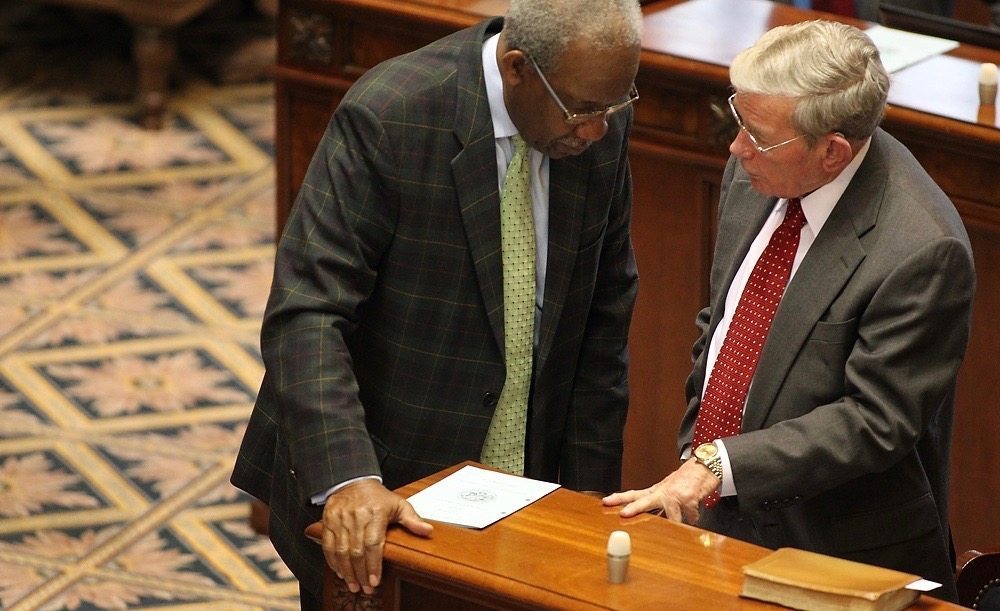IS THE PALMETTO STATE’S CONSTITUTION “RIGGED” FOR THOSE IN POWER?
S.C. Senate president Hugh Leatherman tightened his grip over the Palmetto State’s all-powerful General Assembly the last time there was an executive branch reshuffling.
Two years later, he’s aiming to preserve his self-serving stranglehold on power as another executive succession looms …
Can he pull off another coup? Or is our state headed for a constitutional crisis?
Leatherman, 85, has been the focus of intense speculation in the aftermath of S.C. governor Nikki Haley‘s decision to accept a diplomatic appointment in the administration of U.S. president-elect Donald Trump.
Assuming Haley is confirmed (which is not necessarily a sure thing), she would resign as governor and be replaced in that office by current S.C. lieutenant governor Henry McMaster. In fact, most believe Trump appointed Haley (who attacked him repeatedly during the 2016 election) in order to clear a path to the governor’s office for McMaster (who endorsed Trump prior to the Palmetto State’s “First in the South” presidential primary).
Assuming everything proceeds according to plan, the executive line of succession from Haley to McMaster is quite clear.
No questions, no controversies …
It’s what happens next that has become quite opaque.
As we exclusively reported last week, a debate is raging in Columbia, S.C. over how McMaster’s office will be filled once he ascends to the Governor’s Mansion.
Of course it’s not the fate of this part-time, virtually powerless post that matters – it is how the office will be filled. And which dominos will fall as a result of it being filled.
(Click to view)
(Via Travis Bell Photography)
First, some background: In South Carolina, supreme power (including broad swaths of executive power) is vested in the legislative branch of government. This is due to the state’s antiquated 1895 constitution, which effectively abolished executive power in the aftermath of reconstruction to ensure that in the event a minority ever assumed the governor’s office – he or she would have no real power.
(No really).
This structure has survived virtually unmolested over the intervening 121 years. There was some modest restructuring of state government in the 1990s under the late governor Carroll Campbell (and some additional tweaking in recent years under Mark Sanford) but by and large the “good ol’ boy” system has maintained its results-challenged rule over the Palmetto State for the last twelve decades.
Democrat, Republican … it has made no difference. South Carolina has continued to lag behind the rest of the nation in almost every important economic, academic and quality of life metric over that time period.
Governors have been limited to the power of the bully pulpit and the veto pen … the latter of which hasn’t been exercised in some time.
Anyway, one modest reform approved by voters in 2012 intends to allow future governors a bit more executive authority – namely the ability to appoint their lieutenant governors (and replace them in the event of a vacancy in that office).
This is of the utmost relevance given the current situation – which will create vacancies in both offices.
As we noted in our report a week ago, this executive appointment reform was passed by voters in 2012 but was not codified until May of 2014. Moreover, most legal scholars believe that the provisions of the constitutional change do not go into effect until November 2018 – which is the time frame contained in the language approved by voters.
There is also precedent to support that interpretation.
The last time the lieutenant governor’s office became vacant it was filled – after a lengthy game of musical chairs – by the president of the State Senate. Of course, because the office is so weak, no one in the Senate wanted it except a white Democrat who was likely to lose his seat in the next election.
Seriously: They literally couldn’t give the lieutenant governorship away …
In fact, one powerful Republican Senator actually resigned the presidency of the Senate to avoid become lieutenant governor – and numerous other Republican Senators took a pass on accepting the office in his stead.
(Click to view)
(Via Travis Bell Photography)
This bizarre succession took place in June of 2014 – one month after the recent constitutional reforms were codified. Why is that significant? Because it firmly establishes the ongoing validity of the existing method of succession – meaning the “new” method of filling a vacancy in the lieutenant governor’s office (i.e. letting the governor appoint a replacement) does not take effect until after November 2018.
Leatherman used the existing method to his benefit in 2014 – taking over the presidency of the State Senate immediately after the impotent lieutenant governorship had been filled by his Democratic buddy.
Only two Senators – including current S.C. Senate majority leader Shane Massey – opposed him.
“I don’t think what’s happened is decent,” Massey said of Leatherman’s machinations at the time. “It is indecent.”
Massey added that Leatherman’s manipulation of the process was a “coup.”
Having gained the presidency of the State Senate using one interpretation of the constitution, Leatherman is now hoping to keep the powerful office by invoking another interpretation.
Specifically, he has announced that whatever happens with regard to Haley and McMaster he is “staying in the Senate.”
“I have no ambition for statewide office,” Leatherman said in a statement released this week. “I will not leave my Senate seat to serve as Lieutenant Governor. For me, there is no greater honor than serving in the South Carolina Senate.”
Honor? Right. No greater power more like it …
To keep his powerful post, Leatherman is aggressively advancing the notion that McMaster – upon succeeding Haley as governor – has the authority to appoint his own replacement (presumably from outside the State Senate).
Such a scenario would keep Leatherman from having to surrender either the presidency of the Senate or his powerful perch as chairman of the Senate’s finance committee.
In other words, we’re supposed to ignore the 2014 succession method that enabled Leatherman to seize the leadership of the Senate in the first place.
The debate over the proper method of succession is likely headed to court – but as we’ve repeatedly pointed out the judicial branch in South Carolina is invariably a rubber stamp for the wishes of powerful lawmakers (or at best an impotent critic).
Which leads us to the real (and all-too familiar) problem: Power-hungry politicians picking and choosing how the law is enforced.
Actually, this is much worse than that. What we are dealing with in this case is a power-hungry politician attempting to rewrite the constitution for his own benefit.
That really is a coup.
We don’t know yet which interpretation of the constitution is correct – but permitting those in power to define this document based exclusively on their desire to gain or preserve power is not how representative democracy works.
It is, however, how banana republics operate.
(Banner via Travis Bell Photography)


